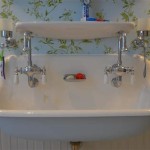How to Remove a Bathroom Sink Drain
Removing a bathroom sink drain is a common plumbing task often required for repairs or replacements. While seemingly straightforward, the process requires an understanding of the different drain types and appropriate tools. This article provides a step-by-step guide to removing common bathroom sink drain assemblies.
Tools and Materials
Gathering the necessary tools and materials beforehand streamlines the removal process. Here's what you'll typically need:
- Bucket
- Pliers (Channel-lock and Slip-joint)
- Adjustable wrench
- Screwdriver (Flathead and Phillips)
- Putty knife
- Old towels or rags
- Safety glasses
- (Optional) Drain wrench
- (Optional) Basin wrench
Identifying the Drain Type
Bathroom sinks utilize various drain assemblies, each requiring a slightly different removal approach. The most common types include:
- Pop-up drain
- Push-and-seal drain
- Lift-and-turn drain
Correctly identifying the drain type is crucial for selecting the appropriate removal steps.
Removing a Pop-Up Drain
The pop-up drain is a common type characterized by a lever at the back of the faucet that controls the stopper. Removal involves the following steps:
- Disconnect the pivot rod: Locate the pivot rod, a thin metal rod connecting the lever to the drain stopper. Disconnect it from the stopper mechanism under the sink.
- Remove the clevis strap: The clevis strap secures the pop-up assembly to the drain pipe. Loosen the nut connecting the clevis strap and remove it.
- Unscrew the body: Unscrew the pop-up drain body from the tailpiece, which extends from the sink drain down to the P-trap.
- Remove the stopper: With the pop-up body removed, the stopper can be lifted out of the sink drain opening.
Removing a Push-and-Seal Drain
Push-and-seal drains operate by pressing down on the stopper to close and again to open. Their removal is generally simpler than pop-up drains:
- Remove the stopper: Simply pull up firmly on the stopper to remove it. Some models may require a slight twisting motion.
- Unscrew the drain flange: Unscrew the drain flange from the sink using channel-lock pliers or an adjustable wrench. A drain wrench can make this process easier.
Removing a Lift-and-Turn Drain
The lift-and-turn drain requires turning the stopper to seal or open the drain. Removal is similar to a pop-up drain but without the pivot rod mechanism:
- Unscrew the stopper: Turn the stopper counter-clockwise to remove it from the drain body.
- Unscrew the drain flange: Use pliers or an adjustable wrench to unscrew the drain flange from the sink. A drain wrench can be helpful.
Detaching the Drain Pipe
Once the drain assembly is removed from the sink, the tailpiece and P-trap assembly must be detached. This involves:
- Loosen the slip nuts: Slip nuts connect the tailpiece to the drain flange and to the P-trap. Loosen these nuts by hand or with pliers.
- Remove the P-trap: Carefully remove the P-trap, allowing any remaining water to drain into the bucket.
- Clean the pipes: Once the drain assembly is removed, take the opportunity to clean the tailpiece and P-trap of any debris or buildup.
Dealing with Difficult Drain Removal
Sometimes, drain assemblies become corroded or seized, making removal difficult. In these cases, consider the following:
- Penetrating oil: Applying penetrating oil to the threads can help loosen stubborn connections. Allow the oil to soak for a few minutes before attempting to loosen the nuts.
- Heat application: Carefully applying heat with a heat gun can help loosen the connection. Exercise caution to avoid damaging the sink or surrounding materials.
- Basin wrench: A basin wrench can provide extra leverage for loosening difficult nuts located in tight spaces under the sink.
Protecting the Sink
Throughout the removal process, take precautions to prevent damage to the sink finish:
- Place towels: Position old towels or rags around the sink to protect the finish from scratches caused by tools.
- Avoid excessive force: While firm pressure may be necessary, avoid using excessive force, which can damage the sink or the drain components.
By understanding the type of drain assembly and utilizing the appropriate tools and techniques, one can effectively remove a bathroom sink drain for repair or replacement. Remember that safety should always be a priority. If unsure about any step, consult a qualified plumber.

How To Replace A Rusty Sink Drain Howtolou Com

How To Remove A Bathroom Sink Stopper Take Out Pop Up Drain From

How To Remove A Sink Stopper The Home Depot

How To Replace A Bathroom Sink Drain

How To Remove A Sink Stopper The Home Depot

How To Replace A Sink Stopper Quick And Simple Home Repair

Sink Drain Replacement Bathroom

How To Replace A Drain In The Bathroom Sink Right Way

How To Remove A Bathroom Sink Drain Ehow

Quick Tip 26 Pop Up Stopper Sticks Misterfix It Com







